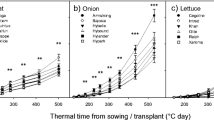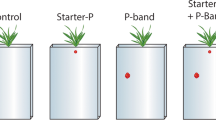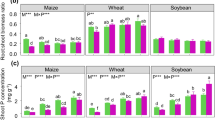Abstract
Background and aims
Roots have morphological plasticity to adapt to heterogeneous nutrient distribution in soil, but little is known about crop differences in root plasticity. The objective of this study was to evaluate root morphological strategies of four crop species in response to soil zones enriched with different nutrients.
Methods
Four crop species that are common in intercropping systems [maize (Zea mays L.), wheat (Triticum aestivum L.), faba bean (Vicia faba L.), and chickpea (Cicer arietinum L.)] and have contrasting root morphological traits were grown for 45 days under uniform or localized nitrogen and phosphorus supply.
Results
For each species tested, the nutrient supply patterns had no effect on shoot biomass and specific root length. However, localized supply of ammonium plus phosphorus induced maize and wheat root proliferation in the nutrient-rich zone. Localized supply of ammonium alone suppressed the whole root growth of chickpea and maize, whereas localized phosphorus plus ammonium reversed (maize and chickpea ) the negative effect of ammonium. The localized root proliferation of chickpea in a nutrient-rich zone did not increase the whole root length and root surface area. Faba bean had no significant response to localized nutrient supply.
Conclusions
The root morphological plasticity is influenced by nutrient-specific and species-specific responses, with the greater plasticity in graminaceous (eg. maize) than leguminous species (eg. faba bean and chickpea).





Similar content being viewed by others
References
Banik P, Midya A, Sarkar BK, Ghose SS (2006) Wheat and chickpea intercropping systems in an additive series experiment: Advantages and weed smothering. Eur J Agron 24:325–332
Ding X, Fu L, Liu C, Chen F, Hoffland E, Shen J, Zhang F, Feng G (2011) Positive feedback between acidification and organic phosphate mineralization in the rhizosphere of maize (Zea mays L.). Plant Soil 349(1–2):13–24
Drew MC (1975) Comparison of the effects of a localized supply of phosphate, nitrate, ammonium and potassium on the growth of the seminal root system, and the shoot, in barley. New Phytol 75:479–490
Drew MC, Saker LR (1978) Nutrient supply and the growth of the seminal root system in barley. III. Compensatory increases in growth of lateral roots and in rates of phosphate uptake in response to localized supply of phosphate. J Exp Bot 29:435–451
Drew MC, Saker LR, Ashley TW (1973) Nutrient supply and the growth of the seminal root system in barley. I. The effect of nitrate concentration on the growth of axes and laterals. J Exp Bot 24:1189–1202
Duncan WG, Ohlrogge AJ (1958) Principles of nutrient uptake from fertilizer bands II. Root development in the band. Agron J 50:605–608
Duncan WG, Ohlrogge AJ (1959) Principles of nutrient uptake from fertilizer bands: III. Band volume, concentration, and nutrient composition. Agron J 51:103–108
Eissenstat DM, Caldwell MM (1988) Seasonal timing of root growth in favorable microsites. Ecol 69:870–873
Fan MX, Mackenzie AE (1995) The toxicity of banded urea to corn growth and yield as influenced by triple superphosphate. Can J Soil Sci 75:117–122
Fan FL, Zhang FS, Song YN, Sun JH, Bao XG, Guo TW, Li L (2006) Nitrogen fixation of faba bean (Vicia faba L.) interacting with a non-legume in two contrasting intercropping systems. Plant Soil 283:275–286
Farley RA, Fitter AH (1999) The responses of seven co-occurring woodland herbaceous perennials to localized nutrient-rich patches. J Ecol 87:688–696
Fitter AH (1994) Architecture and biomass allocation as components of the plastic response of root systems to soil heterogeneity. In: Hutchings MJ, John EA, Stewart AJA (eds) Exploitation of environmental heterogeneity by plants. Academic, San Diego, pp 305–322
Fransen B, de Kroon H (2001) Long-term disadvantages of selective root placement: Root proliferation and shoot biomass of two perennial grass species in a 2-year experiment. J Ecol 89:711–722
Fransen B, Blijjenberg J, de Kroon H (1999) Root morphological and physiological plasticity of perennial grass species and the exploitation of spatial and temporal heterogeneous nutrient patches. Plant Soil 211(2):179–189
Gerendás J, Zhu Z, Bendixen R, Ratcliffe RG, Sattelmacher B (1997) Physiological and biochemical processes related to ammonium toxicity in higher plants. J Plant Nutr Soil Sci 160(2):239–251
Granato TC, Raper CD Jr (1989) Proliferation of maize (Zea mays L.) roots in response to localized supply of nitrate. J Exp Bot 40:263–275
Gross KL, Pregitizer KS, Burton AJ (1995) Spatial variation in nitrogen availability in three successional plant communities. J Ecol 83:357–367
Guo JH, Liu XJ, Zhang Y, Shen JL, Han WX, Zhang WF, Christie P, Goulding K, Vitousek P, Zhang FS (2010) Significant acidification in major Chinese croplands. Science 327:1008–1010
He Y, Liao H, Yan X (2003) Localised supply of phosphorus induces root morphological and architectural changes of rice in split and stratified soil cultures. Plant Soil 248:247–256
He WM, Shen Y, Cornelissen JHC (2012) Soil nutrient patchiness and plant genotypes interact on the production potential and decomposition of root and shoot litter: evidence from short-term laboratory experiments with Triticum aestivum. Plant Soil 353:145–154
Hodge A (2004) The plastic plant: root responses to heterogeneous supplies of nutrients. New Phytol 162:9–24
Hodge A (2006) Plastic plants and patchy soils. J Exp Bot 57(2):401–411
Hodge A (2009) Root decisions. Plant Cell Environ 32:628–640
Hodge A, Stewart J, Robinson D, Griffiths BS, Fitter AH (1998) Root proliferation, soil fauna and plant nitrogen capture from nutrient-rich patches in soil. New Phytol 139:479–494
Hodge A, Robinson D, Griffiths BS, Fitter AH (1999) Why plants bother: Root proliferation results in increased nitrogen capture from an organic patch when two grasses compete. Plant Cell Environ 22:811–820
Hodge A, Stewart J, Robinson D, Griffiths BS, Fitter AH (2000) Spatial and physical heterogeneity of N supply from soil does not influence N capture by two grass species. Funct Ecol 14:645–653
Hutchings MJ, de Kroon H (1994) Foraging in plants: The role of morphological plasticity in resource acquisition. Adv Ecol Res 25:159–238
Hutchings MJ, John EA (2004) The effects of environmental heterogeneity on root growth and root/shoot partitioning. Ann Bot 94:1–8
Jackson RB, Caldwell MM (1993) Geostatistical patterns of soil heterogeneity around individual perennial plants. J Ecol 81:683–692
Jing J, Rui Y, Zhang F, Rengel Z, Shen J (2010) Localized application of phosphorus and ammonium improves growth of maize seedlings by stimulating root proliferation and rhizosphere acidification. Field Crop Res 119:335–364
Johnson HA, Biondini ME (2001) Root morphological plasticity and nitrogen uptake of 59 plant species from the Great Plains grasslands, U.S.A. Basic Appl Ecol 2:127–14
Johnson CM, Ulrich A (1959) Analytical methods for use in plant analysis. University of California, Agricultural Experiment Station, Berkeley
Li L, Yang SC, Li XL, Zhang FS, Christie P (1999) Interspecific complementary and competitive interactions between intercropped maize and faba bean. Plant Soil 212:105–114
Li L, Zhang FS, Li XL, Christie P, Sun JH, Yang SC, Tang CX (2003a) Interspecific facilitation of nutrient uptake by intercropped maize and faba bean. Nutr Cycl Agroecosyst 65:61–71
Li L, Tang C, Rengel Z, Zhang FS (2003b) Chickpea facilitates phosphorous uptake by intercropped wheat from an organic phosphorus source. Plant Soil 248:297–303
Li SM, Li L, Zhang FS, Tang C (2004) Acid phosphatase role in chickpea/maize intercropping. Ann Bot (Lond) 94:297–303
Li L, Sun J, Zhang FS, Guo T, Bao X, Smith FA, Smith SE (2006) Root distribution and interactions between intercropped species. Oecologia 147(2):280–290
Li L, Li SM, Sun JH, Zhou LL, Bao XG, Zhang HG, Zhang FS (2007) Diversity enhances agricultural productivity via rhizosphere phosphorus facilitation on phosphorus-deficient soils. Proc Natl Acad Sci 104:11192–11196
Li HB, Zhang FS, Shen JB (2012) Contribution of root proliferation in nutrient-rich soil patches to nutrient uptake and growth of maize. Pedosphere 22(6):776–784
Miller MH, Ohlrogge AJ (1958) Principles of nutrient uptake from fertilizer bands. I. Effect of placement of nitrogen fertilizer on the uptake of band-placed phosphorus at different soil phosphorus levels. Agron J 58:95–97
Mommer L, van Ruijven J, Jansen C, van de Steeg HM, de Kroon H (2012) Interactive effects of nutrient heterogeneity and competition: Implications for root foraging theory? Funct Ecol 26:66–73
Moody PW, Aitken RL, Yo SA, Edwards DG, Bell LC (1995) Effect of banded fertilizers on soil solution composition and short-term root growth I. Ammonium sulphate, ammonium nitrate, potassium nitrate and calcium nitrate. Aust J Soil Res 33:673–687
Officer SJ, Dunbabin VM, Armstrong RD, Norton RM, Kearney GA (2009) Wheat roots proliferate in response to nitrogen and phosphorus fertilisers in Sodosol and Vertosol soils of south-eastern Australia. Aust J Soil Res 47:91–102
Robinson D (1994) The responses of plants to non-uniform supplies of nutrients. New Phytol 127:635–674
Robinson D, Van Vuuren MMI (1998) Responses of wild plants to nutrient patches in relation to growth rate and life-form. In: Lambers H, Poorter H, Van Vuuren MMI (eds) Inherent variation in plant growth. Physiological mechanisms and ecological consequences. Backhuys Publishers, Leiden, pp 237–257
Schachtman DP, Reid RJ, Ayling SM (1998) Phosphorus uptake by plants: From soil to cell. Plant Physiol 116:447–453
Shen J, Mao D (2011) Research methodology of plant nutrition. China Agricultural University Press, Beijing
Shen JB, Yuan LX, Zhang JL, Li HG, Bai ZH, Chen XP, Zhang WF, Zhang FS (2011) Phosphorus dynamics: from soil to plant. Plant Physiol 156:997–1005
Shen JB, Li CJ, Mi GH, Li L, Yuan LX, Jiang RF, Zhang FS (2013) Maximizing root/rhizosphere efficiency to improve crop productivity and nutrient use efficiency in intensive agriculture of China. J Exp Bot 64(5):1181–1192
Shu L, Shen J, Rengel Z, Tang C, Zhang F (2005) Growth medium and phosphorus supply affect cluster root formation and citrate exudation by Lupinus albus grown in a sand/solution split-root system. Plant Soil 276:85–94
Shu L, Shen J, Rengel Z, Tang C, Zhang F (2007a) Cluster root formation by Lupinus albus is modified by stratified application of phosphorus in a split-root system. J Plant Nutr 30:271–288
Shu L, Shen J, Rengel Z, Tang C, Zhang F, Cawthray GR (2007b) Formation of cluster roots and citrate exudation by Lupinus albus in response to localized application of different phosphorus sources. Plant Sci 172:1017–1024
Sun H, Zhang F, Li L, Tang C (2002) The morphological changes of wheat genotypes as affected by the levels of localised phosphate supply. Plant Soil 245:233–238
Valizadeh GR, Rengel Z, Rate AW (2002) Role of phosphorus fertilizer banding and the ratio of nitrate ammonium on the uptake of phosphorus and wheat growth: A glasshouse study. Aust J Exp Agric 42:1095–1102
Valladares F, Sanchez D, Zavala MA (2006) Quantitative estimation of phenotypic plasticity: bridging the gap between the evolutionary concept and its ecological applications. J Ecol 94:1103–1116
van Vuuren MMI, Robinson D, Griffiths BS (1996) Nutrient inflow and root proliferation during the exploitation of a temporally and spatially discrete source of nitrogen in soil. Plant Soil 178:185–192
Vance CP, Uhde-stone C, Allan DL (2003) Phosphorus acquisition and use: Critical adaptations by plants for securing a nonrenewable resource. New Phytol 57:423–427
Watt M, Evans JR (2003) Phosphorus acquisition from soil by white lupin (Lupinus albus L.) and soybean (Glycine max L.), species with contrasting root development. Plant Soil 248:271–283
Weligama C, Tang C, Sale PWG, Conyers MK, Liu DL (2008) Localised nitrate and phosphate application enhances root proliferation by wheat and maximises rhizosphere alkalisation in acid subsoil. Plant Soil 312:101–115
Zhang FS, Li L (2003) Using competitive and facilitative interactions in intercropping systems enhances crop productivity and nutrient-use efficiency. Plant Soil 248:305–312
Zhang FS, Shen JB, Zhang JL, Zuo YM, Li L, Chen XP (2010) Rhizosphere processes and management for improving nutrient use efficiency and crop productivity: Implications for China. Adv Agron 107:1–32
Acknowledgments
This study was supported by the National Natural Science Foundation of China (NSFC) (Nos. 31330070, 30925024 and 31210103906), the Innovative Group Grant of the NSFC (No. 31121062), and the Program of Introducing International Advanced Agricultural Science and Technology of the Ministry of Agriculture of China (948 Program) (No. 2011-G18).
Author information
Authors and Affiliations
Corresponding author
Additional information
Responsible Editor: Alexia Stokes.
Rights and permissions
About this article
Cite this article
Li, H., Ma, Q., Li, H. et al. Root morphological responses to localized nutrient supply differ among crop species with contrasting root traits. Plant Soil 376, 151–163 (2014). https://doi.org/10.1007/s11104-013-1965-9
Received:
Accepted:
Published:
Issue Date:
DOI: https://doi.org/10.1007/s11104-013-1965-9




